1 June 2017
When I scanned this image for the Hull photos site I couldn’t remember where I had taken it, looking up somewhere from the south and east at the R&W Paul silo which still dominates the area close to Scott St Bridge, though now with the name Maizecor. Before taking it I had walked along Lime St and then turned down Jenning St to cross Scott St bridge – something which is unfortunately not now possible.
Working from the picture I’m now sure it was taken from the end of Scott St beside the river, probably from inside the urinal, now long demolished, which was tucked into the corner beside the River Hull and presumably drained into it. Much of the urinal wall in the bottom third of the picture has been knocked down, though a section remained last time I walked past and the concrete lamp post is still there. Quite a sizable tree has now grown in the corner from where I think this picture was taken.
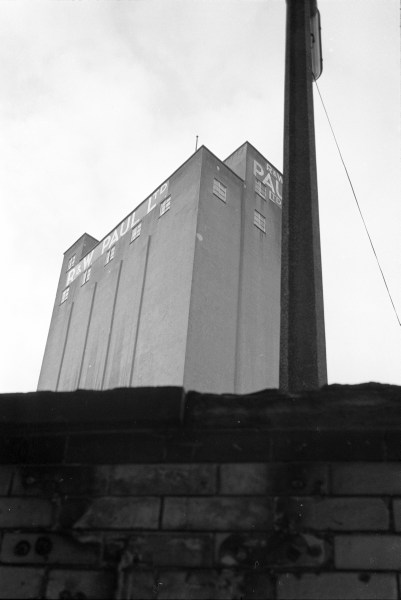
33g25: R&W Paul silo from Scott St urinal, 1982 – River Hull
2 June 2017
The pipe bridge across Lime St is still there, between the riverside wharf on the right and the storage area at the left of the road. The lorry leaving the wharf is from Cargill, a company who, according to their web site have only been operating in Hull since 1985 and operate the ISIS mill in Morley St. Cargill is a giant US private company founded in 1865 and still owned by the Cargill family, with most of its business in food and agricultural products.
The pipe bridge now carries the name ‘IBL Bulk Liquids’ and LIme St is one of two company sites in Hull, the other being at the King George V dock. They began in Hull in 1947 with “a few small tanks on the river Hull”, presumably at this site, storing latex imported from the Far East but now offer a wide rang of bulk liquid storage in Hull. They also offer other services in Hull, including a public weighbridge, and you can see a small sign for this in front of the tanks at the lower centre of the picture.
The vertical tanks, one with a spiral stair around it are still there, just to the south of Hodgson St, but most or all of the others have now gone, although there are still storage tanks along the street. At the end of Lime St the building on the corner close to North Bridge is still there, though no longer a bank. It was at one time a bar, but was empty when I photographed it in February. Some buildings remain on Lime St, but others have been demolished.
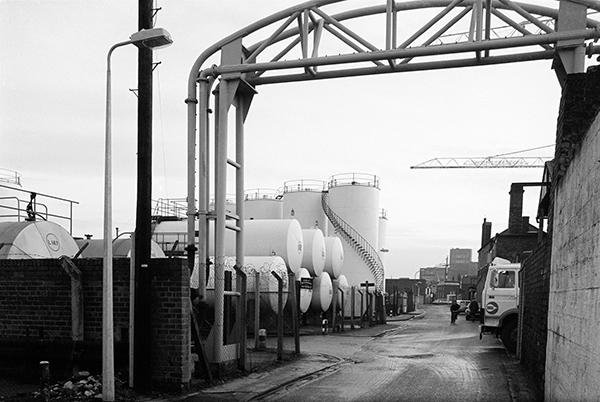
33g35: Bulk storage, Lime St, 1983 – River Hull
3 June 2017
Another view of the Hull Ships Stores on the west bank immediately downstream from North Bridge, with at left the remains of the old North Bridge at the end of Charlotte St, and above that the rear of Hull College. Hull Ships Stores, a ship supplies warehouse built in 1870, architect RG Smith, were Grade II listed in 1994, a few years after they were converted into flats in 1989 as Northbridge House.
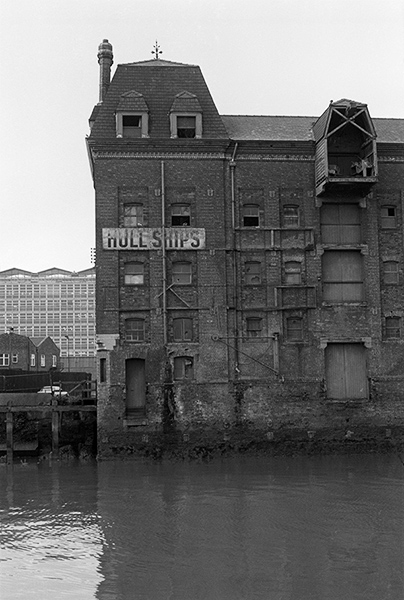
33g52: Hull Ships Stores, Charlotte St, 1982 – River Hull
4 June 2017
It was the name ‘Hull Truss & Surgical Co’ in a curve around the arch above the doorway which I’m sure made me photograph this shop front in Dock St on several occasions, though I never made my way inside. It obviously appealed to others too, as although the shop is long gone, the name has survived and has been repainted on the section of the front wall still standing in a similar fashion above the bricked up doorway. I deliberately framed the ornate bracket above the doorway to make its truncated form resemble a crucifix, seeing the building as a kind of temple to the mysteries within.
The arch has been plastered over and the name repainted in bolder pale blue letters with a white drop shadow effect, and the door and window filled in. It is no longer a shop but simply a brick wall in front of a parking area between ‘The Purple Door’ lap dancing club and a chunky concrete block on the corner of Dock St and Grimston St.
Then the window display was crowded with boxes and posters of body belts, elastic support stockings and tights and condoms. I never saw anyone enter or leave and it seemed tot be on its last legs, with peeling paint. The sun blind was faded, tatty and dirty, and I think no longer ever in use and there was a curious kind of stained glass panel in the top section of the window. Whatever had once been painted on two dark panels inside the archway was no longer visible. The white-painted brick made it a little tricky to photograph, and I’m not sure I ever got the exposure quite right.
Dock St is of course now nowhere near a dock, running parallel to and a short distance north of Queen’s Dock, closed in 1930 and bought by Hull Corporation who partially filled it in during the 1930s to provide a slightly sunken and rather boring public garden, though it does sometimes have some nice flower displays. A “major public realm design competition” for the gardens and neighbouring Queen Victoria Square was announced by Hull Citybuild in 2006, but though much needed appears never to have happened.
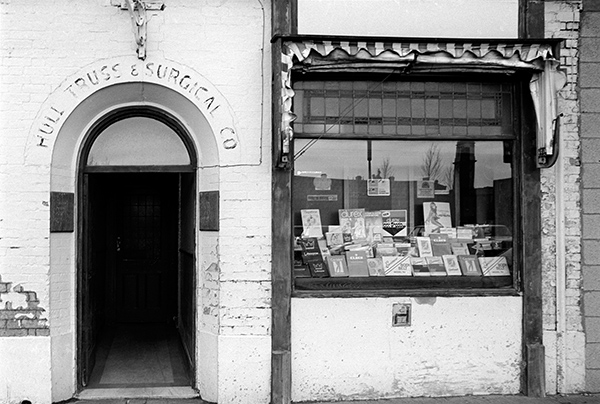
33g53: Hull Truss & Surgical Co’. Dock St, 1982 – City Centre
5th June 2017
Great Union St is a street that most living in Hull avoid, or drive down quickly on their way to Hedon Road or the A63, not a street with a great deal to offer other than traffic. It ran from close to North Bridge to the Hedon Rd, and now continues on to Garrison Rd.
The office through whose window I took this picture was not far south of North Bridge, and the building reflected in it may still be there, just beyond Hyperion St on the East side of the road. Where the office stood is now the parking area at the front of ‘The Crossings’, a hostel and centre for the homeless.
I photographed the interior of this office on several occasions, always from the outside when it was locked and empty.
The poster at right is for Ruston Marine Diesel Engines, a company which dates back to the 1840 engineering and millwright firm started by James Toyne Proctor and Theophilus Burton in Lincoln in 1840; Joseph Ruston joined them as a partner in 1857, but Burton didn’t get on with the new partner and left the following year and the firm became Ruston Proctor & Co. They had great success building traction engines and steam locomotive and had 1,600 employees when they became a limited company in 1889.
During the First World War they were Britain’s largest builder of aircraft engines, producing them for 1,600 Sopwith Camels. In 1981 they with Richard Hornsby & Sons of Grantham, becoming Ruston & Hornsby Ltd.
Rustons were unsuccessful when they tried to become car manufacturers after the First World War, building cars that were too heavy and too expensive (perhaps based on their wartime experience as builders of some of the first tanks) but soon became a major producer of small and medium size diesel engines for gas turbines, railway locomotives and marine use.
Rustons were taken over by English Electic in 1966, who moved diesel projection to their Stafford and Newton-le-Willows factory, and later became part of GEC, whose logo is at bottom left of the poster. The gas turbine division which remained in Lincoln was later merged with the French company Alsthom and was sold to Siemens in 2003.
The ship in the poster is the 1597 tonne coaster Surreybrook, built in Selby in 1971. She sailed under a whole string of names – 1982 Romana – 1990 Lito – 1991 God Spirit – 1993 Aquarius – 1994 Serenade – 1998 City Of London, although a photograph taken of the CIty of London shows her original name still faintly visible. Berthed in distress in the harbour at Marseilles in January 1999 she left only to be towed away to the breakers at Aliaga in Turkey in September 2003.
PoLadaire is a trade mark of Porter-Lancastrian Ltd of Bolton who made refrigeration equipment, vital for freezing fish at sea and conveying other perishable goods, and at the extreme left is part of another poster about diesel engines with the GEC logo.
But the main point of the picture for me when I took it was the empty plinth, protected by ropes. I saw it as signifying the state of industry, particularly the fishing industry, in Hull. Though a few months later when I walked past again I made another image in which the plinth was occupied.
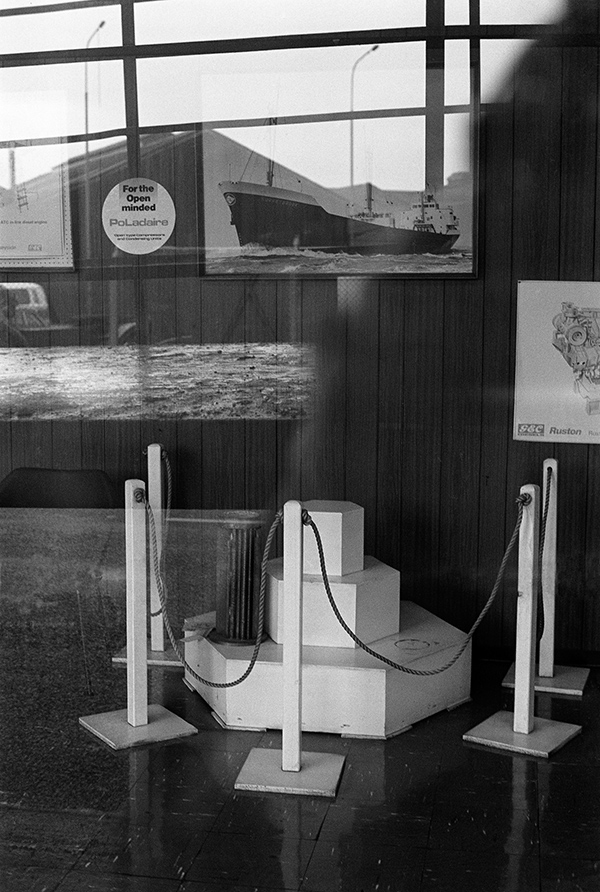
33g61: Empty plinth, Great Union St, 1982 – East Hull
6th June 2017
I took what was for me at the time the remarkable number of six frames with more or less the same view (this was the first) as the boat moved slowly away under Drypool Bridge downriver, the final three in portrait mode to capture more of the reflection at left.
The buildings at the extreme left are still there, though I think re-roofed, and the tall buildings behind of what is now the Gamebore cartridges but was then part of Rank’s Clarence Mills are still there but now off-white. The main building of the Clarence Mill behind the ship is now sadly gone – a great loss to Hull – and as yet nothing has taken its place, with plans for a hideous hotel to provide beds for Hull’s year as city of culture having fallen through. Also gone now is the warehouse building just the the right of the bridge, and the sheds of the dry dock at right.
The bridges across the Hull opened fairly regularly back in 1982, causing long holdups in the traffic, but openings now are rare events, and much of the traffic goes over the Myton Bridge which has a much greater clearance above the water. Few if any vessels come up the River Hull now which would need it to swing open.
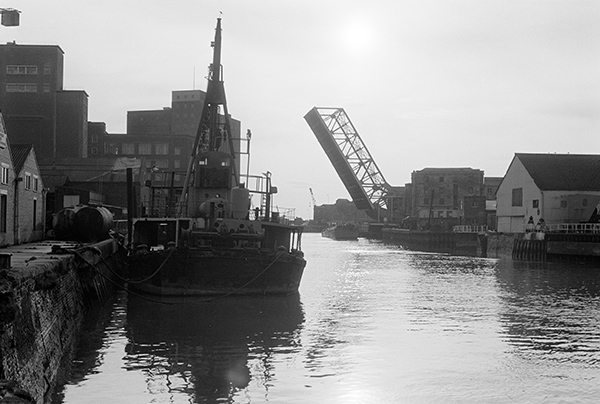
33g62: River Hull and Drypool Bridge, 1982 – River Hull
7th June 2017
Joseph Rank Ltd had mills both north and south of Clarence St immediately to the east of Drypool Bridge, and both were largely destroyed by bombing and the subsequent fires in May 1941.
The mill to the north of Clarence St was rebuilt and in part was the Blue Cross Animals Feed premises which remained in use until around the mid-1980s when the site became the Gamebore Cartridge Company. Blue Cross was Rank’s trade name for animal feeds.
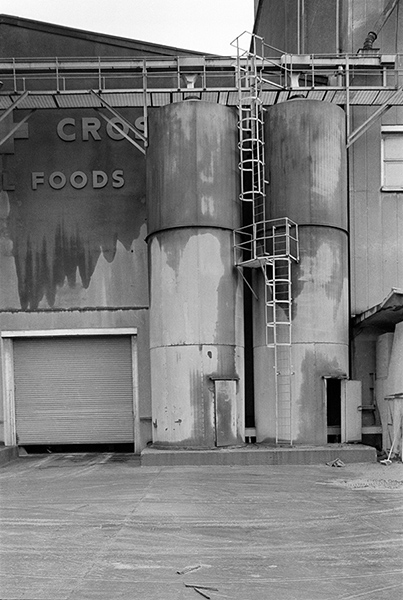
33h12: Blue Cross animal feed mill, Clarence St, 1982 – River Hull
You can see the new pictures added each day at Hull Photos, and I post them with the short comments above on Facebook.
Comments and corrections to captions are welcome here or on Facebook.
______________________________________________________
There are no adverts on this site and it receives no sponsorship, and I like to keep it that way. But it does take a considerable amount of my time and thought, and if you enjoy reading it, a small donation – perhaps the cost of a beer – would be appreciated.
My London Diary : Buildings of London : River Lea/Lee Valley : London’s Industrial Heritage
All photographs on this and my other sites, unless otherwise stated, are taken by and copyright of Peter Marshall, and are available for reproduction or can be bought as prints.